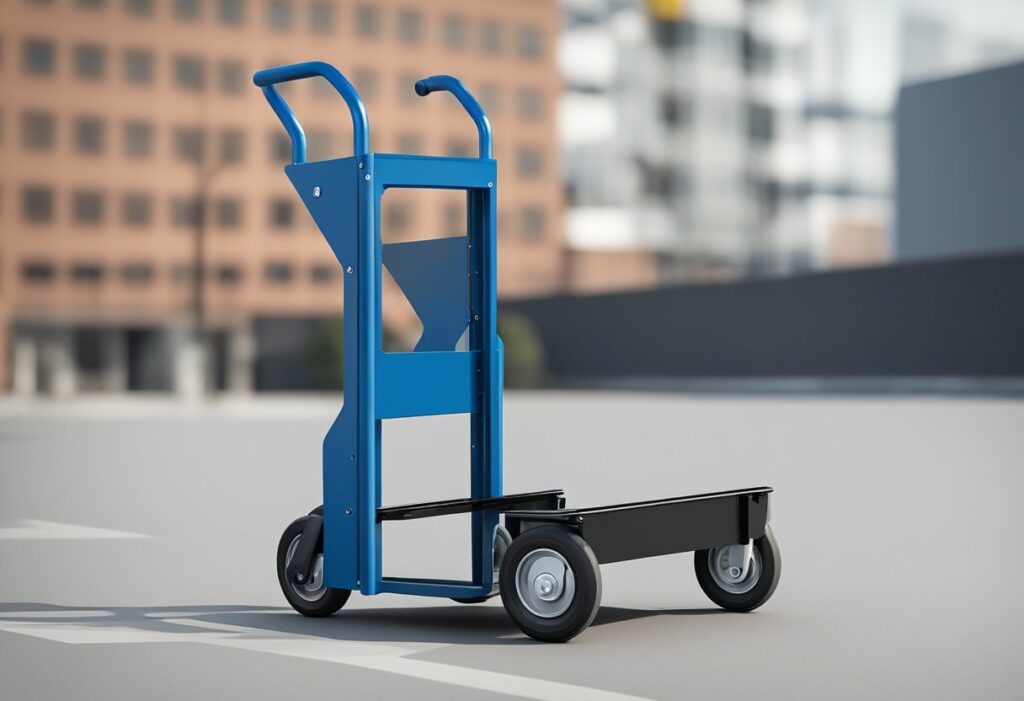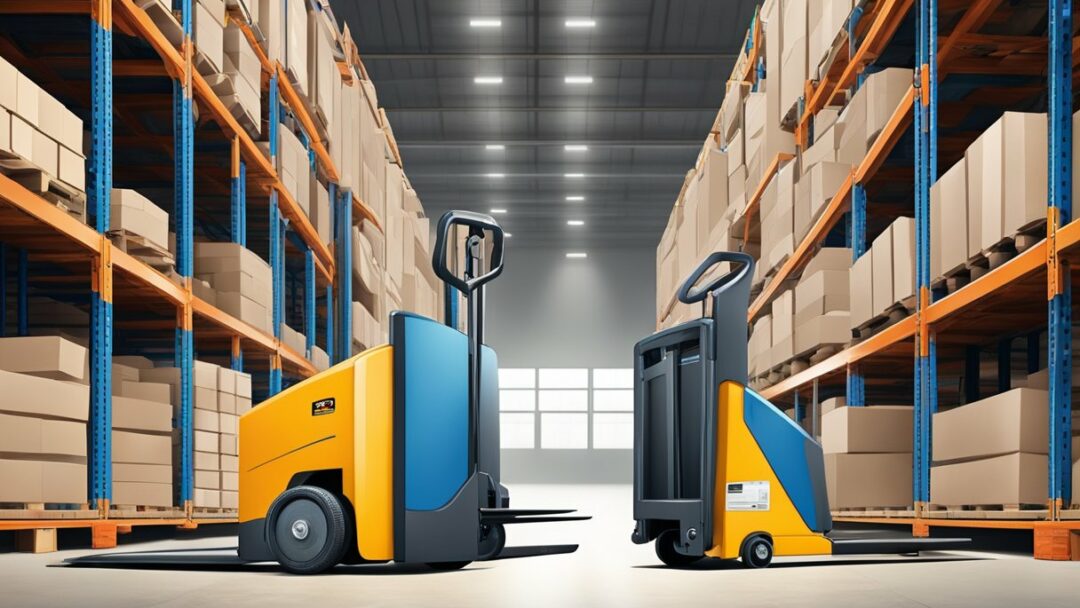When it comes to moving heavy or bulky items, the right equipment can make all the difference. Hand trucks and dollies are two popular choices that can ease the burden of transporting loads. The primary aim of this article is to provide a comprehensive understanding of the differences between hand trucks and dollies, their various advantages and applications, as well as factors to consider when purchasing one.
Hand trucks, sometimes referred to as two-wheelers or sack trucks, are L-shaped carriers with two or four wheels designed to move heavy or bulky items. On the other hand, dollies are essentially large platforms with two to four wheels used for moving small or large items. Both hand trucks and dollies have their distinct design advantages and disadvantages, which influence their usability in a range of situations.
Selecting between a hand truck or a dolly depends on a variety of factors, such as the size, weight, and type of the items being moved, as well as the intended use case and environment in which they will be operating. Ultimately, the choice comes down to the user’s specific needs in terms of productivity, efficiency, and safety.
Key Takeaways
- Hand trucks and dollies differ in design, with hand trucks being L-shaped and dollies being flat platforms.
- Both types of equipment have diverse usability and applications depending on the load size, weight, and usage requirements.
- Choosing the right equipment requires assessing factors like intended use, safety, and productivity needs.
Understanding Hand Trucks and Dollies
What Is a Hand Truck?
A hand truck, also known as a sack truck or box cart, is a manual tool designed to assist in the transport of heavy or bulky items. It typically features two wheels at the base, a narrow platform as the base, and a vertical handle at the top. To use a hand truck, one simply tilts the truck back on its wheels, slides the base under an item, and then moves the item by rolling the truck forward. Hand trucks come in various designs, including steel, aluminum, and folding constructions, catering to specific user needs and load capacities.
Some benefits of hand trucks are:
- Load capacity: Hand trucks can typically support loads of up to 500 lbs, making them suitable for moving heavy items
- Maneuverability: Two-wheeled design makes it easy to move through tight spaces
- Compact size: Many hand trucks can be folded or otherwise made compact for easy storage
What Is a Dolly?
A dolly, also known as a platform cart or wheelcart, is another manual tool used for transporting heavy objects. Dollies usually have a flat platform supported by four wheels, which allows the user to place objects on the platform and move them with ease. Dollies are available in various sizes, from small furniture dollies to large construction site wheelcarts.
Some advantages of using dollies are:
- Versatility: Dollies come in many sizes and can accommodate large or awkwardly shaped items
- Stability: Four-wheeled design provides balance and ease of maneuverability
- Load capacity: Some dollies can support much heavier loads than hand trucks, depending on their design and construction
When choosing between a hand truck or a dolly, it is essential to consider the items you need to transport and the mobility required. Hand trucks are ideal for narrow spaces and easy storage, while dollies work well for larger, heavier items or those requiring more stability during transport.
Design and Structure
Hand Truck Design Features
Hand trucks, also known as sack trucks or trolleys, are typically designed with an upright structure that features a handle at the top and two wheels at the base. The handle allows for easy control and maneuverability of the hand truck, while the two wheels enable the device to easily roll over various surfaces. Most hand trucks have a small ledge near the bottom, on which items can be placed and tilted back for effortless transportation. The upright design allows users to navigate tight spaces and transport tall or stacked items with ease.
Key components of a hand truck include:
- Handle: For comfortable grip and control
- Two wheels: Enables smooth movement across surfaces
- Ledge: Area for placing items during transportation
Dolly Design Variations
Dollies, on the other hand, typically comprise a flat platform with four wheels at each corner, providing a stable base for items to be placed upon. The addition of a handle helps users navigate the load, although some dollies are designed without an attached handle. Dollies are versatile due to their varying sizes and weight capacities, which allow them to handle a wide range of loads, including heavy, bulky items.
Notable aspects of a dolly include:
- Four wheels: Ensures stability and easy maneuverability
- Flat platform: Offers a large surface area for items
- Handle: Can be included for improved control (though not always present)
In summary, hand trucks and dollies have distinct design features that cater to different transportation needs. Hand trucks are characterized by their upright design, handle, and two wheels, which makes them ideal for moving tall or stacked items in narrow spaces. Contrastingly, dollies feature four wheels and a flat platform, providing stability and versatility for moving heavier and larger loads.

Functional Differences
Weight Capacity and Load Distribution
Hand trucks and dollies have different weight capacities and load distributions. Hand trucks typically have a smaller weight capacity compared to dollies, making them suitable for moving lighter loads such as boxes and small appliances. On the other hand, dollies are designed for moving heavy, bulky items like furniture or appliances and have a large weight capacity.
- Hand trucks: Ideal for lighter loads, typically up to 600 lbs.
- Dollies: Suitable for heavier loads, can handle weight up to 1,500 lbs or more.
The load distribution also varies between the two tools. Hand trucks have a vertical frame and a base plate, suitable for lifting and transporting vertically stacked items. Dollies offer a flat surface, accommodating a wide variety of objects.
Maneuverability and Stability
Maneuverability and stability are essential factors to consider when choosing between a hand truck and a dolly. Hand trucks are designed for easy maneuvering in tight spaces due to their vertical orientation and two-wheel design. However, they may require more force to start moving or to maintain balance if loaded unevenly compared to a dolly.
Dollies, with their four-wheel design, provide excellent stability, making them easier to maneuver even with heavier loads. They also require less effort to start and stop moving, which is beneficial for transporting larger items on a flat surface.
- Hand trucks: Vertical orientation, two-wheel design enables easy maneuvering in tight spaces
- Dollies: Four-wheel design provides excellent stability and ease of movement on flat surfaces
Surface Adaptability
The type of surface you are working with can dictate the effectiveness of either a hand truck or a dolly. Hand trucks are better-suited for use on relatively smooth surfaces like pavement or warehouse floors. While transitioning between two levels might require additional effort, hand trucks equipped with proper wheels can handle mildly uneven terrain such as door thresholds and small curbs.
In contrast, dollies are better suited for level surfaces due to their low ground clearance and wide platform. Using a dolly on uneven ground can be challenging without proper wheel configurations. However, on smooth, flat surfaces, dollies excel at moving heavy objects with ease.
- Hand trucks: Best for smooth surfaces with minimal height differences; can handle small curbs or thresholds.
- Dollies: Ideal for smooth, level surfaces; may struggle with uneven terrain or significant height differences.
Usability and Applications
Moving Boxes and Appliances
Hand trucks and dollies are two essential tools for moving various objects from one place to another. Each has distinct advantages when it comes to handling specific types of loads, which can influence which tool is best suited for the task at hand.
Hand trucks are particularly well-suited for moving boxes and appliances. These vertically structured tools have a frame generally in an L-shape, with two large wheels at the base for easy movement. They allow for the stacking of multiple boxes to be efficiently transported at once, as well as provide the leverage needed for heavier appliances like refrigerators, washing machines, or other large household equipment.
Dollies, on the other hand, are low-grip wheeled platforms with a flat surface, making them an excellent choice for securing larger boxes or single-piece appliances. Their stability and smooth maneuverability make them ideal for moving items with a broader base or that require additional support.
Transporting Furniture and Bulky Items
When it comes to moving furniture and other bulky objects, each tool offers unique advantages.
Dollies shine in this category due to their ability to handle large, cumbersome items. Their four wheels and flat surfaces provide stability and ease of movement, which is often necessary for safely transporting items such as sofas, dressers, or heavy equipment.
For smaller pieces of furniture, like chairs or smaller shelves, a hand truck can also be an effective choice. The vertical frame allows for better handling of these items, as well as the option to stack multiple items on the hand truck if necessary.
Handling Small or Multiple Items
Both hand trucks and dollies can be great options for moving smaller or multiple items at once, depending on the situation.
- Hand trucks are suitable for:
- Stacking and moving multiple smaller boxes
- Transporting tall, narrow items
- Carrying items up or downstairs with ease (if equipped with stair-climbing capabilities)
- Dollies are suitable for:
- Placing multiple items side by side on the dolly’s flat surface
- Carrying elongated or wide items
- Easily maneuvering items around corners or through tight spaces
Ultimately, the choice between a hand truck and a dolly will depend on the specific requirements of the task at hand. Both tools offer valuable advantages in different situations, so it is essential to choose the right one based on the items being moved and the overall needs of the job.
Safety and Injury Prevention
Proper Usage of Hand Trucks
Hand trucks are designed to make moving heavy items more manageable, reducing the risk of injury. To ensure safe transportation, it is essential to follow proper usage guidelines:
- Choose the right hand truck: Opt for a hand truck with a weight capacity suitable for the load you intend to carry. Hand trucks are available in different sizes and material constructions, like steel and aluminum.
- Inspect the hand truck: Before use, check all components, including wheels, handles, and platform, for any visible defects or damages.
- Load items correctly: Place the heaviest items on the bottom and distribute the load evenly to maintain balance. Avoid overloading or stacking items too high as it can lead to instability.
- Tilt with care: When tilting the hand truck back, do so gently to prevent the load from shifting or falling.
- Control and steer: Maintain a firm grip on the handle and walk slowly, keeping the hand truck in an angled position for easy control and steering.
- Safety on slopes and stairs: When using the hand truck on slopes or stairs, ensure that the load is secured and approach the incline at a slow, controlled pace.
Dolly Safety Tips
Dollies provide an efficient solution for moving bulky objects. Safeguarding yourself and the items being transported requires adherence to safety practices:
- Select the appropriate dolly: Pick a dolly with the adequate size and weight capacity to accommodate the load you need to transport. Pay attention to the dolly’s wheel configuration, especially when maneuvering on uneven surfaces.
- Inspect before use: Routinely inspect your dolly for signs of wear or damage in its wheels, frame, and other components.
- Follow loading guidelines: Place heavy items on the bottom and secure items with straps, if necessary, to prevent shifts during movement.
- Navigating curves: When navigating turns with a dolly, maintain a slow speed and turn gradually to avoid tipping while keeping the items stable.
- Balancing load: Make sure the dolly is balanced during any tilt or turning process to minimize the risk of injuries caused by sudden shifts or falling items.
By adhering to safety guidelines and using hand trucks and dollies responsibly, users can minimize the risk of injuries and incidents while moving heavy items. Remember, proper usage is key to ensuring both the transported items and those using the equipment remain unharmed.
Advantages of Each Option
Benefits of Hand Trucks
Hand trucks provide a number of advantages when it comes to moving heavy items. One key benefit is their efficiency in transporting loads, allowing users to move multiple items without the need for multiple trips. This is primarily due to their vertical design, which helps save space and allows for taller objects to be easily moved.
Enhanced maneuverability is another significant advantage of hand trucks. Their large wheels offer excellent stability and make it easier to navigate various terrains, including stairs and longer distances. Some hand trucks even come with four wheels instead of two or casters, further improving their maneuverability.
Benefits of Dollies
Dollies, on the other hand, also offer several advantages for moving items. Firstly, they provide a stable and flat surface for items to be placed, making them suitable for moving large objects like furniture and appliances. Additionally, dollies typically have four wheels which allow for better weight distribution and make them ideal for transporting bulky or irregularly shaped items.
When it comes to maneuverability, dollies are equipped with swivel casters that provide the flexibility to easily navigate corners and tight spaces. This feature makes them a superior choice for moving items within confined areas or limited floor space.
In summary, both hand trucks and dollies offer their own unique set of benefits when it comes to moving items. Hand trucks are more efficient and versatile with enhanced maneuverability, while dollies excel at moving large or bulky objects through tight spaces. Choosing between the two tools ultimately depends on the specific requirements of the task at hand.
Considerations for Purchase
Assessing Needs and Environment
When deciding between a hand truck and a dolly, it is important to consider the specific needs and environment in which the equipment will be utilized. Hand trucks are best suited for moving small and heavy items or moving small items in bulk due to their vertical L-shaped design with an upright handle and two wheels. Dollies, on the other hand, have a raised, flat platform that typically has four wheels, making them ideal for moving larger, bulkier items.
It is essential to evaluate the types of items to be transported, the surface on which the equipment will be used, and the space available for maneuverability.
Material and Build Quality
Material and build quality play a significant role in the performance and durability of both hand trucks and dollies. Common materials used for these tools include:
- Aluminum: Lightweight and resistant to corrosion, making it suitable for both indoor and outdoor environments.
- Steel: Robust and durable, but prone to rust if exposed to moisture. Ideal for heavy-duty applications.
- Plastic: Lightweight and easy to maintain, but may not be as durable as metal options.
In addition to the materials, consider the build quality of the wheels and casters, as this can greatly impact the ease of transport and overall user experience. A good wheel combination includes swivel casters for maneuverability and fixed casters to maintain a straight path when needed.
Long-Term Usage and Storage
Depending on the frequency of use and the type of items being moved, durability and ease of storage should be considered when purchasing a hand truck or dolly. Hand trucks often have a folding design, allowing for easy storage when not in use. Dollies, though versatile in size, might require more space for storage due to their flat surface.
Additionally, consider any accessories or additional features that may make the task more efficient, such as straps for securing items or adjustable handles to accommodate different user heights. These features will contribute to long-term usage and overall satisfaction with the chosen equipment.

Variants and Specialized Use-Cases
When it comes to moving heavy or bulky items, there are various types of hand trucks and dollies available, each designed to cater to specific needs and applications. In this section, we will discuss the specialized use-cases and different types of both hand trucks and dollies.
Specialized Hand Trucks
Upright Hand Truck: The traditional upright hand truck is the most common type, featuring two wheels, a handle at the top, and a small ledge at the bottom. It serves as a general-purpose tool for transporting various items, especially in warehouses and retail environments.
Appliance Hand Truck: Specifically designed for moving large household appliances, an appliance hand truck has additional features like a strap and extra padding to secure and protect the items being moved.
Convertible Hand Truck: A versatile option, convertible hand trucks can function as both an upright hand truck for stacking and a four-wheel horizontal cart. This dual functionality is useful for various moving scenarios, as it enables easy transition between different methods of transport.
Different Types of Dollies
Appliance Dolly: Similar to an appliance hand truck, an appliance dolly is designed for moving large household appliances. It is usually larger and more stable, with four wheels, making it suitable for heavier and bulkier items.
Furniture Dolly: Furniture dollies are flat and rectangular, featuring four swivel wheels for easy mobility. They are ideal for moving large, heavy pieces of furniture, such as tables, sofas, or cabinets.
Aside from these specific types, there are many other variations of hand trucks and dollies to suit a wide range of applications. When selecting the right tool, consider factors such as the materials being moved, the environment (including flooring), and the specific needs of the task at hand.
Enhancing Productivity and Efficiency
Strategies for Effective Handling
When it comes to handling heavy equipment in warehouses, the right choice of equipment, such as hand trucks or dollies, can significantly impact productivity and efficiency. Hand trucks are typically used for their high load capacity, often ranging from 600 lbs as a hand truck to 800 lbs as a dolly. Dollies are useful for their flat platforms, which provide stable bases for large and bulky items.
To maximize efficiency and reduce risks during loading and unloading processes, some key strategies include:
- Selecting the appropriate equipment: Based on the size, weight, and shape of the items being moved, choose the most suitable hand truck or dolly.
- Streamlined navigation: Ensure clear paths and well-organized warehouse layouts, with ample space for maneuvering hand trucks or dollies.
- Optimizing loads: To minimize strain on the equipment and operator, avoid overloading and distribute the weight of items evenly.
Ergonomic Practices
In addition to proper handling strategies, implementing ergonomic practices is essential to reduce the risk of injury, enhance productivity, and facilitate efficient control of heavy equipment.
Here are some examples of ergonomic practices to consider:
- Adjustable handles: Hand trucks and dollies with height-adjustable handles can accommodate various user heights, reducing strain on the back, neck, and shoulders.
- Grip enhancement: Utilizing ergonomic grips promotes better control over the equipment, leading to smoother and safer moving processes.
- Training: Ensure operators receive adequate training on safe lifting techniques, proper equipment usage, and body mechanics for optimal ergonomic practices.
By systematically adopting effective handling strategies and ergonomic practices, warehouses can enhance productivity and efficiency, while ensuring the safe and controlled operation of hand trucks and dollies.
Frequently Asked Questions
What are the main differences in usage between a hand truck and a dolly?
A hand truck has a vertical, L-shaped design with an upright handle, two wheels, and a small bottom ledge. It is best suited for moving small and heavy items or moving small items in bulk. On the other hand, a dolly has a raised, flat platform that typically has four wheels, making it ideal for moving larger, bulkier items, such as furniture or appliances.
What are the advantages of using an appliance dolly over a traditional hand truck?
An appliance dolly is specifically designed for moving large appliances or other heavy items, often featuring straps to help secure the load. They can efficiently carry bulky items up or down stairs and their four-wheel design provides better balance and stability compared to a traditional hand truck.
How do the features of convertible hand trucks compare to standard dollies?
Convertible hand trucks offer versatility, allowing users to switch between a typical hand truck configuration and a four-wheel dolly configuration. This feature enables them to handle a wide range of loads and tasks, making them useful in many situations where a standard dolly or hand truck may not suffice.
What should be considered when choosing the best hand truck for moving heavy items?
When choosing a hand truck for heavy items, consider factors such as weight capacity, construction materials, wheel type, and maneuverability. Look for hand trucks with a high weight capacity, sturdy construction, and wheels suitable for the terrain where it will be used. Some hand trucks may also include additional features such as stair climbers or convertible designs for added functionality.
How does one decide between purchasing a hand truck from retailers like Harbor Freight, Home Depot, or Costco?
To decide on a retailer for purchasing a hand truck, consider factors such as price, quality, warranty, and customer reviews. While all three retailers offer a selection of hand trucks, compare specific models and price points to find the best fit for your needs and budget. Additionally, pay attention to customer reviews to get a better understanding of the performance and durability of each hand truck.
What is the primary function of a hand truck in material handling?
The primary function of a hand truck in material handling is to facilitate the transportation of heavy or bulky items, making it easier for workers to move materials within warehouses, stores, or other workspaces. Hand trucks can help improve efficiency, reduce physical strain, and increase workplace safety by minimizing the risks associated with lifting and moving heavy loads.

